最新下载
热门教程
- 1
- 2
- 3
- 4
- 5
- 6
- 7
- 8
- 9
- 10
Springboot如何优雅地进行字段校验 Springboot优雅地进行字段校验代码示例
时间:2021-01-05 编辑:袖梨 来源:一聚教程网
Springboot如何优雅地进行字段校验?本篇文章小编给大家分享一下Springboot优雅地进行字段校验代码示例,小编觉得挺不错的,现在分享给大家供大家参考,有需要的小伙伴们可以来看看。
Controller层 VS Service层
去网上查阅了一些资料,一般推荐与业务无关的放在Controller层中进行校验,而与业务有关的放在Service层中进行校验。那么如何将参数校验写的优雅美观呢,如果都是if - else,就感觉代码写的很low,还好有轮子可以使用
常用校验工具类
使用Hibernate Validate
引入依赖
org.hibernate hibernate-validator 4.3.1.Final
常用注解说明
使用姿势
需要搭配在Controller中搭配@Validated或@Valid注解一起使用,@Validated和@Valid注解区别不是很大,一般情况下任选一个即可,区别如下:
虽然@Validated比@Valid更加强大,在@Valid之上提供了分组功能和验证排序功能,不过在实际项目中一直没有用到过
Hibernate-validate框架中的注解是需要加在实体中一起使用的
定义一个实体
public class DataSetSaveVO {
//唯一标识符为空
@NotBlank(message = "user uuid is empty")
//用户名称只能是字母和数字
@Pattern(regexp = "^[a-z0-9]+$", message = "user names can only be alphabetic and numeric")
@Length(max = 48, message = "user uuid length over 48 byte")
private String userUuid;
//数据集名称只能是字母和数字
@Pattern(regexp = "^[A-Za-z0-9]+$", message = "data set names can only be letters and Numbers")
//文件名称过长
@Length(max = 48, message = "file name too long")
//文件名称为空
@NotBlank(message = "file name is empty")
private String name;
//数据集描述最多为256字节
@Length(max = 256, message = "data set description length over 256 byte")
//数据集描述为空
@NotBlank(message = "data set description is null")
private String description;
}
说明:message字段为不符合校验规则时抛出的异常信息
Controller层中的方法
@PostMapping
public ResponseVO createDataSet(@Valid @RequestBody DataSetSaveVO dataSetVO) {
return ResponseUtil.success(dataSetService.saveDataSet(dataSetVO));
}
说明:在校验的实体DataSetSaveVO旁边添加@Valid或@Validated注解
使用commons-lang3
引入依赖
org.apache.commons commons-lang3 3.4
常用方法说明
测试代码
//StringUtils.isEmpty
System.out.println(StringUtils.isEmpty("")); //true
System.out.println(StringUtils.isEmpty(" ")); //false
//StringUtils.isNotEmpty
System.out.println(StringUtils.isNotEmpty("")); //false
//StringUtils.isBlank
System.out.println(StringUtils.isBlank("")); //true
System.out.println(StringUtils.isBlank(" ")); //true
//StringUtils.isNotBlank
System.out.println(StringUtils.isNotBlank(" ")); //false
List emptyList = new ArrayList<>();
List nullList = null;
List notEmptyList = new ArrayList<>();
notEmptyList.add(1);
//CollectionUtils.isEmpty
System.out.println(CollectionUtils.isEmpty(emptyList)); //true
System.out.println(CollectionUtils.isEmpty(nullList)); //true
System.out.println(CollectionUtils.isEmpty(notEmptyList)); //false
//CollectionUtils.isNotEmpty
System.out.println(CollectionUtils.isNotEmpty(emptyList)); //false
System.out.println(CollectionUtils.isNotEmpty(nullList)); //false
System.out.println(CollectionUtils.isNotEmpty(notEmptyList)); //true
相关文章
- SpringBoot自定义bean绑定解析 10-24
- Javaweb工程运行报错HTTP Status 404解决教程 10-20
- JAVA获取jvm和操作系统相关信息方法 10-20
- BeanFactory和FactoryBean的区别讲解 10-20
- 微信小程序的宿主环境实现教程 10-10
- dispatchEvent解决重叠元素响应事件教程 10-10

















